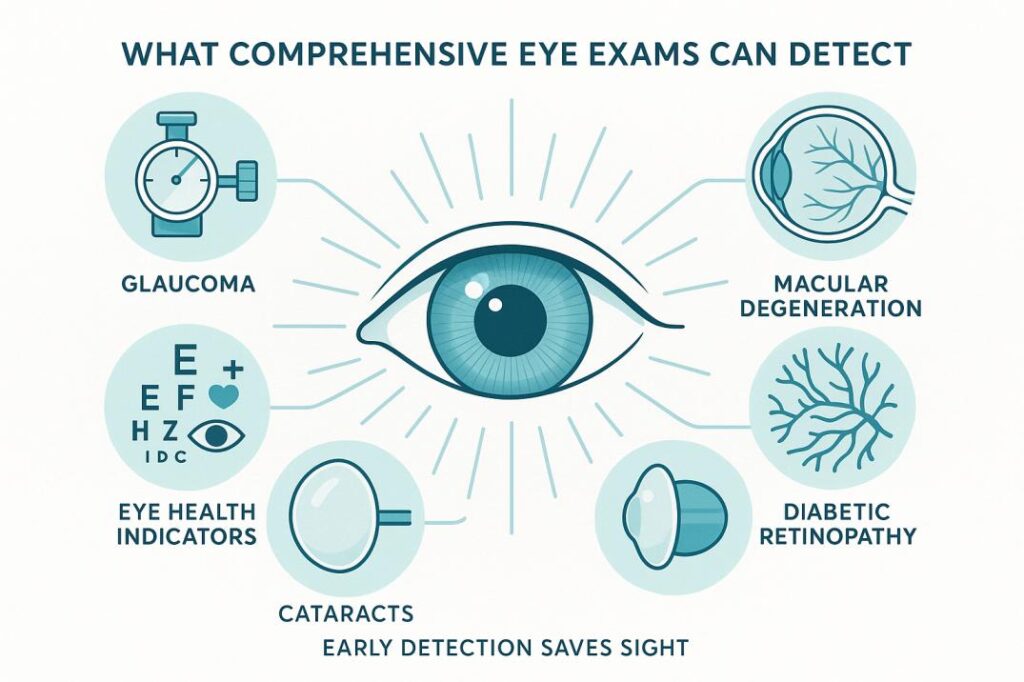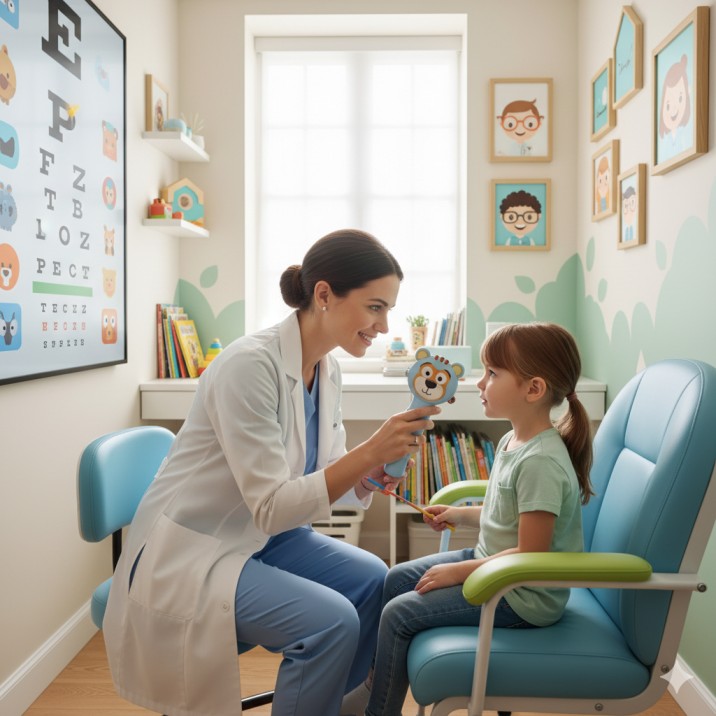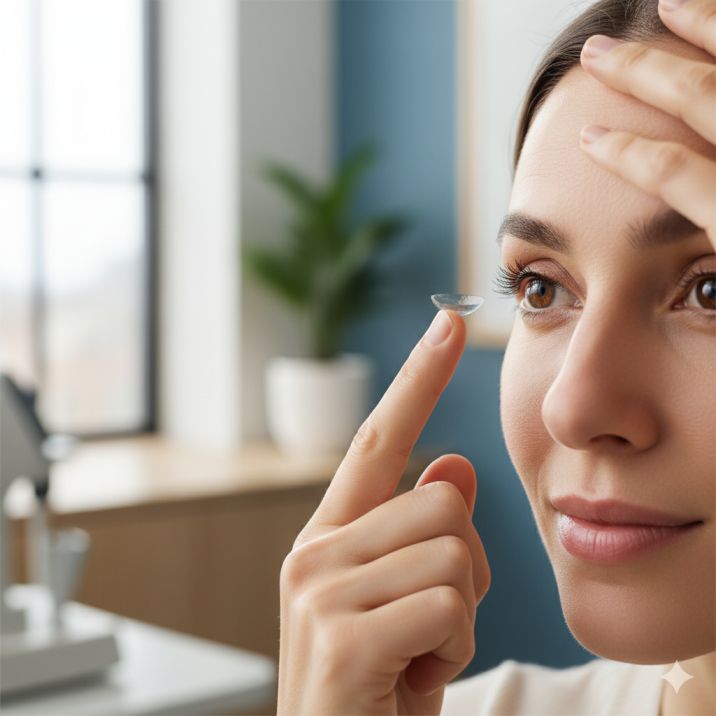Eye Exams vs. Vision Screenings: Why the Difference Matters
Understanding Your Vision Care Options
When it comes to protecting your vision, understanding the difference between an eye exam and a vision screening ranks among the most important health decisions you’ll make. While both serve valuable purposes in eye care, they offer vastly different levels of protection for your long-term vision health.
The Bottom Line: Vision screenings are quick tests designed to identify obvious vision problems, while comprehensive eye exams provide thorough evaluations of both your vision and overall eye health. Only a comprehensive eye exam can detect serious conditions like glaucoma, macular degeneration, and diabetic retinopathy in their early, treatable stages.
Consider this sobering statistic: about one in four children in the U.S. has an undiagnosed or untreated vision problem. For adults, the stakes are equally high—many serious eye diseases develop silently, without symptoms, until irreversible damage has occurred.
The choice between a basic screening and comprehensive professional care isn’t just about seeing today; it’s about preserving your vision for life.
What Is a Vision Screening?
A vision screening is a basic test designed to quickly identify potential vision problems that may require further evaluation. Think of it as the first line of defense in eye care – useful, but limited in scope.
Common Vision Screening Components
Visual Acuity Testing
- Reading letters or symbols from a Snellen eye chart at 20 feet
- Testing each eye separately to identify obvious refractive errors
- Typically takes 5-10 minutes to complete
Basic Eye Inspection
- Checking pupil response to light
- Observing eye alignment and general appearance
- Looking for obvious abnormalities
Photoscreening (Sometimes)
- Using special cameras to detect refractive errors
- Automated process requiring minimal training
- Often used in community health programs
Where Vision Screenings Happen
- Schools: Annual or bi-annual screenings for students
- Workplace health fairs: Employee wellness programs
- DMV offices: License renewal requirements
- Primary care offices: Part of routine physical exams
- Community health events: Free screenings at shopping centers or health fairs
The Value of Vision Screenings
Vision screenings serve an important purpose by identifying people who may need professional eye care. About one in four children in the U.S. has an undiagnosed or untreated vision problem, making these screenings valuable for catching obvious issues that might otherwise go unnoticed.
However, it’s crucial to understand their limitations.
What Is a Comprehensive Eye Exam?
A comprehensive eye exam is a thorough evaluation of your vision and eye health conducted by an optometrist or ophthalmologist. This detailed assessment goes far beyond checking whether you can see clearly – it’s designed to detect eye diseases, assess overall eye health, and even identify systemic health conditions.
What to Expect During Your Comprehensive Eye Exam
Medical and Family History Review. Your eye doctor will discuss your health history, medications, and any vision concerns. Many eye conditions tend to be hereditary, so family history plays a crucial role in determining your risk factors.
Advanced Visual Testing
- Visual acuity: Testing both distance and near vision
- Refraction: Determining your exact prescription for glasses or contacts
- Binocular vision: Assessing how well your eyes work together
- Contrast sensitivity: Measuring your ability to distinguish objects from backgrounds
Eye Health Evaluation
- Dilated fundus examination: Looking inside your eye at the retina, optic nerve, and blood vessels
- Tonometry: Measuring eye pressure to screen for glaucoma
- Slit-lamp examination: Detailed view of eye structures, including cornea, lens, and anterior chamber
- Peripheral vision testing: Checking for signs of glaucoma or neurological issues
Specialized Testing When Needed
- Optical Coherence Tomography (OCT): High-resolution imaging of retinal layers
- Visual field testing: Comprehensive mapping of your peripheral vision
- Fundus photography: Documenting and monitoring changes in your retina over time
Why Vision Screenings Aren’t Enough
The False Security Problem
People often misunderstand what passing a vision screening means. The information obtained from a vision screening is comparable to the information obtained from a blood pressure measurement. Just as normal blood pressure doesn’t mean you don’t have other health problems, passing a vision screening doesn’t guarantee healthy eyes.
What Vision Screenings Miss
Silent Eye Diseases
- Glaucoma: Called the ‘silent thief of sight’, as many don’t notice until significant, irreversible vision loss has already occurred
- Diabetic retinopathy: Often develops without symptoms until advanced stages
- Macular degeneration: The leading cause of vision loss and blindness in Americans aged 65 years and older
Visual Skills Deficits: Many children can pass basic vision screening, but still struggle with:
- Eye tracking and focusing abilities
- Eye teaming coordination
- Depth perception issues
- Near vision problems affecting reading and computer work
Early-Stage Conditions Most school-based vision screenings do not detect the majority of vision problems that can make it harder for children to learn in school. These limitations apply to adults as well, where early detection is crucial for treatment success.
The Power of Early Detection Through Comprehensive Eye Exams
Life-Changing Impact of Early Diagnosis
Recent advances in eye care technology have revolutionized our ability to detect and treat eye diseases before they cause irreversible vision loss. Modern eye care is equipped with advanced diagnostic technology that makes it easier to detect early signs of eye diseases.
Breakthrough Technologies
- OCT imaging: Provides detailed views of retinal layers, enabling early detection of macular degeneration
- Automated visual field testing: Identifies glaucoma damage years before symptoms appear
- Digital fundus photography: Documents changes over time for precise monitoring
Recent Scientific Evidence
Study 1: AI-Enhanced Early Detection (2025) Research published in 2025 shows that a revolutionary early screening tool using AI may help detect glaucoma by analyzing eye movements and retinal patterns to identify risk factors before traditional testing methods can detect them.
Study 2: Retinal Changes and Systemic Health (2025) A February 2025 study identified that retinal changes may serve as an early indicator for Alzheimer’s disease, demonstrating how comprehensive eye exams can reveal broader health concerns beyond vision.
Study 3: Mobile Technology for Pediatric Detection (2024) Published in JAMA Network Open, researchers developed an AI model that can accurately identify myopia, strabismus, and ptosis in children using mobile photographs, showing promise for expanded screening capabilities.
Conditions Best Detected Through Comprehensive Exams
Age-Related Macular Degeneration (AMD)
- Affects central vision needed for reading and driving
- Approximately 2 million Americans currently have AMD (2024 data)
- The leading cause of vision loss and blindness in Americans aged 65 and older
- Early treatment can slow progression significantly
- Often called the “silent thief of sight” due to the lack of early symptoms
- Affects millions of people worldwide, with increasing prevalence
- Early detection enables treatments that preserve vision
- Regular pressure testing and optic nerve evaluation are essential
- Leading cause of blindness in working-age adults
- Can develop without symptoms until advanced stages
- Regular monitoring is essential for people with diabetes
- Comprehensive eye exams can detect more than 270 systemic health conditions
Age-Specific Recommendations: When You Need What
Children and Teens (Birth to 18)
First Year of Life
- Comprehensive eye exam by 6-12 months
- Critical for detecting conditions like amblyopia and strabismus
- Early eye exams are important for detecting vision problems that can affect learning and development
Preschool Years (3-5)
- Annual comprehensive eye exams are recommended
- An estimated 25 percent of all children in the United States have vision problems.
- Even children who “pass” school screenings may have undetected issues
School Age (6-18)
- Annual exams for children with vision correction
- Every two years for those without known issues
- Today, learning relies heavily on students having both clear eyesight and strong vision skills needed to successfully use computers, read, and comprehend texts
Adults (18-64)
Young Adults (18-39)
- Comprehensive exam every 2-3 years if no risk factors
- Annual exams for those with:
- Family history of eye disease
- High myopia
- Diabetes or hypertension
- Previous eye injuries
Middle Age (40-64)
- The eyes go through continuous changes between the ages of 40 and 64
- Presbyopia typically begins around age 45
- Increased risk for glaucoma and other age-related conditions
- Recommended frequency: every 1-2 years
Seniors (65+)
Annual Comprehensive Exams Essential
- Once you reach age 65, we recommend having a complete eye exam every year
- Higher risk for:
- Cataracts
- Glaucoma
- Macular degeneration
- Diabetic retinopathy
Special Considerations for Seattle Professionals
Digital Eye Strain and Modern Work
Many Seattle professionals spend 8+ hours daily on computers in the tech, healthcare, and knowledge work sectors. This lifestyle creates unique vision challenges that basic screenings simply cannot address:
Computer Vision Syndrome Symptoms Common in Seattle Workplaces
- Blurry vision after computer work
- Dry, irritated eyes exacerbated by indoor heating systems
- Headaches and neck strain from poor screen positioning
- Difficulty focusing between distances during long work sessions
Comprehensive Solutions for Seattle’s Work Environment. Our thorough exams evaluate:
- Near point stress and accommodation for prolonged screen use
- Dry eye assessment with specialized testing (particularly important in Seattle’s indoor-heated environments)
- Blue light sensitivity evaluation for the Pacific Northwest’s limited natural light
- Customized computer vision solutions for local work demands
Environmental Factors in the Pacific Northwest
Seattle’s unique environment affects eye health in ways that require professional assessment:
Seasonal Light Changes Affecting Vision
- Limited winter sunlight affects circadian rhythms and eye comfort
- Increased indoor lighting dependence requires accurate color vision testing
- Seasonal dry eye considerations due to heating systems and low humidity
- UV exposure variations require customized protection recommendations
Outdoor Recreation Risks in Washington State
- UV exposure from water and snow reflection during skiing, hiking, and water sports
- Eye injury prevention for popular Pacific Northwest activities
- Protective eyewear recommendations for sailing, mountain climbing, and cycling
- Altitude-related vision considerations for mountain recreation
Making the Right Choice for Your Family
When to Choose Vision Screening
Vision screenings are appropriate for:
- Initial checkpoints in schools or community health programs
- Workplace wellness components for general health awareness
- Quick assessments when professional eye care isn’t immediately available
When You Need a Comprehensive Eye Exam
Schedule a comprehensive eye exam when:
- Following up on failed vision screenings
- You have symptoms like headaches, blurry vision, or eye strain
- It’s time for routine care based on age and risk factors
- Family history indicates increased eye disease risk
- You have systemic conditions like diabetes or hypertension
Red Flags That Require Immediate Professional Care
For Children:
- Frequent eye rubbing or blinking
- Holding books or devices very close
- Squinting or tilting the head to see
- Poor performance in school despite adequate intelligence
- Complaints of headaches or tired eyes
For Adults:
- Sudden vision changes
- Persistent eye pain or discomfort
- Flashing lights or new floaters
- Difficulty seeing at night
- Changes in peripheral vision
The Investment in Your Vision Health
Understanding the Value
While vision screenings may be free or low-cost, they provide only basic information. Comprehensive eye exams represent a significant investment in your long-term vision and overall health.
What You’re Investing In:
- Advanced diagnostic technology that can detect diseases years before symptoms appear
- Professional expertise from doctors trained to identify subtle signs of eye disease
- Personalized treatment plans tailored to your specific needs and lifestyle
- Long-term vision preservation through early intervention and monitoring
Insurance and Healthcare Planning
Many insurance plans, including most employer-sponsored vision benefits, cover comprehensive eye exams. Check with your provider about:
- Annual exam coverage
- Frequency limitations
- Specialist referral requirements
- Coverage for advanced testing when medically necessary
Technology’s Role in Modern Eye Care
Diagnostic Advances Changing the Game
Optical Coherence Tomography (OCT) This non-invasive imaging provides unprecedented detail of retinal layers, enabling detection of:
- Early macular degeneration
- Glaucoma nerve damage
- Diabetic retinal changes
- Retinal swelling or scarring
Automated Visual Field Testing Advanced perimetry can detect:
- Early glaucoma damage
- Neurological conditions affecting vision
- Medication side effects on peripheral vision
- Progressive changes over time
Digital Fundus Photography High-resolution retinal imaging allows:
- Detailed documentation of eye health
- Comparison of changes over the years
- Early detection of systemic diseases
- Patient education through visual evidence
The Limitations of DIY and Online Testing
While smartphone apps and online vision tests have gained popularity, they cannot replace professional comprehensive eye care. Online vision tests attempt to replace one element of an eye examination, the refraction, to yield a prescription for glasses or contacts. It is not unlike taking a blood pressure reading at a kiosk and expecting a prescription.
Your Next Steps: Prioritizing Your Vision Health
Creating Your Eye Care Plan
Assess Your Risk Level:
- Family history of eye disease
- Current health conditions
- Age and lifestyle factors
- Previous eye injuries or surgeries
Establish a Baseline: If you haven’t had a comprehensive eye exam in over two years, schedule one now to establish your baseline eye health status.
Plan Regular Follow-ups: Work with your eye care provider to determine the appropriate frequency for your individual needs.
Questions to Ask During Your Comprehensive Eye Exam
- “What is my risk for developing eye diseases?”
- “How often should I have comprehensive eye exams?”
- “Are there lifestyle changes that could benefit my eye health?”
- “What symptoms should prompt me to call immediately?”
- “How can I protect my eyes during computer work?”
Resources and Citations
This article is based on research from authoritative medical and eye care organizations. For additional information and professional guidelines, refer to these key resources:
1. American Optometric Association – Comprehensive Eye Exams
URL: https://www.aoa.org/healthy-eyes/caring-for-your-eyes/eye-exams
Description: Official AOA guidelines on comprehensive eye and vision examinations, including recommended frequency for different age groups and components of professional eye care. This resource provides evidence-based recommendations for eye care professionals and patients.
2. National Eye Institute – Eye Health Information
URL: https://www.nei.nih.gov/learn-about-eye-health/healthy-vision/get-free-or-low-cost-eye-care
Description: Comprehensive information from the NIH’s National Eye Institute about eye diseases, vision screening programs, and resources for affordable eye care. Includes current statistics on vision problems and early detection.
3. WebMD – Vision Screening vs. Eye Exam Differences
URL: https://www.webmd.com/eye-health/difference-between-vision-screening-and-eye-exam
Description: Medical resource explaining the practical differences between vision screenings and comprehensive eye exams, including what each type of assessment can and cannot detect. Updated with current medical guidance and patient information.
Note: These resources were accessed and reviewed for accuracy as of August 2025. For the most current medical recommendations, consult with a qualified eye care professional.
Conclusion: Your Vision Deserves Nothing Less Than Excellence
Your vision is irreplaceable. The investment in comprehensive professional eye care today protects not merely your ability to see clearly, but your quality of life, independence, and overall health for decades to come. When you consider that comprehensive eye exams can detect over 270 systemic health conditions—from diabetes and high blood pressure to neurological disorders—the value extends far beyond vision correction.
The choice is yours, but the stakes couldn’t be higher. Every day you delay comprehensive eye care is a day that silent eye diseases may be progressing, stealing your sight while you remain unaware. The technology exists, the expertise is available, and the treatments are more effective than ever—but only when conditions are caught early.
Take action today. Schedule your comprehensive eye examination and give your vision the professional care it deserves. Your future self—and your family who depends on you—will thank you for making this crucial investment in your health and wellbeing.
FAQs
-
Eye exams are comprehensive evaluations by eye doctors that diagnose diseases and check overall eye health, lasting 60+ minutes. Vision screenings are basic 30-minute tests that only identify potential problems.




